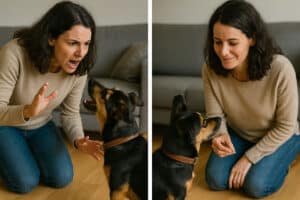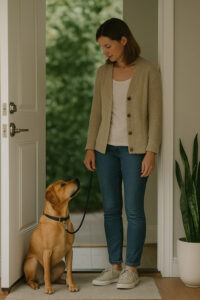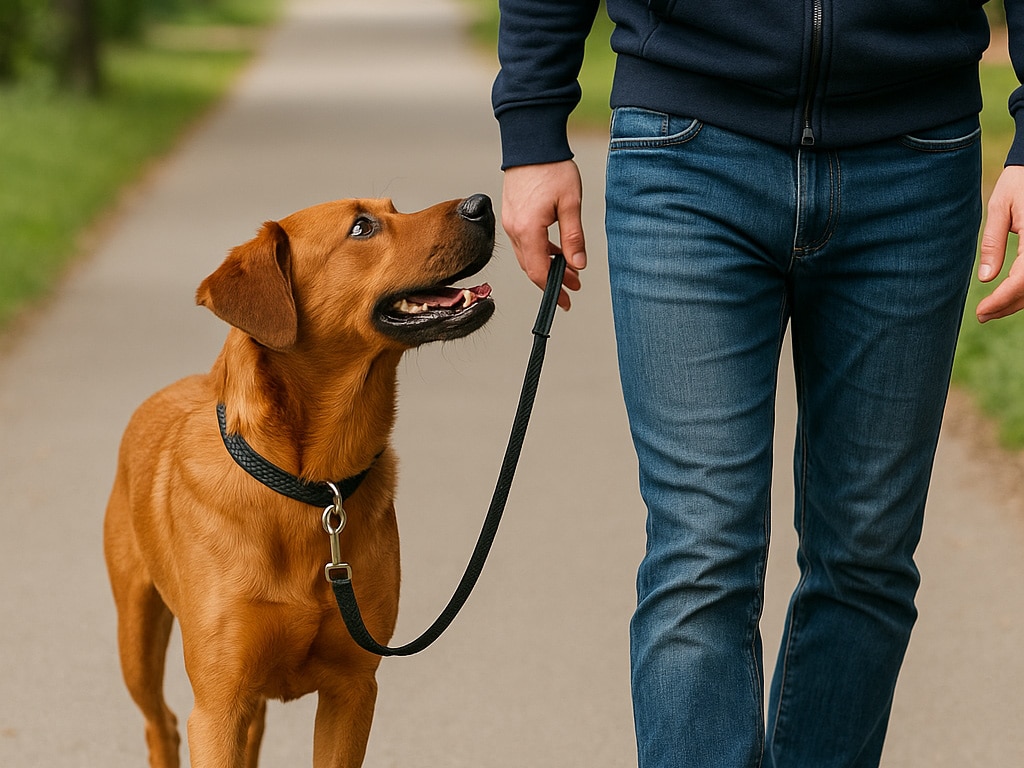How to Be a Confident Leader isn’t just a catchy idea — it’s the heart of successful dog training in Hamilton. When you learn to lead with calm confidence, your dog responds with clarity, trust, and reliability. If you’re a first-time dog owner, or you’ve been second-guessing your every move, this guide will teach you how to step into leadership in a way that actually works for your dog — and feels natural to you.
What Does It Mean to Be a Confident Leader in Dog Training?
Let’s get something straight from the beginning: being a leader in dog training does not mean being controlling, loud, dominant, or harsh. You don’t need to act like a drill sergeant. You don’t need to be the “alpha.” That outdated thinking causes more harm than good.
A confident leader is someone who communicates clearly, stays consistent, and creates safety for the dog. It’s someone who can navigate both calm and chaotic moments without becoming overwhelmed. It’s someone who builds trust through presence — not pressure.
Your dog doesn’t need perfection. But they do need predictability. They need you to be the steady point in a fast-moving world. That’s where leadership begins.
Why Is Leadership So Important in Dog Training?
Dogs are expert observers. They’re constantly watching us — not just for cues, but for clues about what’s happening next. And when they feel a lack of leadership, they fill the gap themselves. That’s when you see dogs barking at the window, lunging on walks, ignoring recalls, or acting hyperactive and unfocused.
But let’s be clear — these aren’t “bad dogs.” These are dogs making decisions in the absence of guidance. If you’re inconsistent, reactive, emotional, or unsure, your dog doesn’t know where to look for direction.
Now flip that.
When you act with calm confidence, your dog stops guessing. They stop taking over. They begin to relax, wait, and follow — not because they’re afraid of you, but because your leadership brings clarity to their world. They trust you’ll guide them through each situation, so they don’t have to make choices under stress.
That trust is built. And in our Hamilton dog training programs, that’s what we teach owners to cultivate — one moment at a time.
The Cost of Insecure, Inconsistent Leadership
Many dog owners don’t realise that the problem isn’t that their dog is “stubborn” or “too distracted” — it’s that the leadership being offered is inconsistent or emotionally charged.
When leadership lacks confidence, here’s what typically happens:
- Dogs start ignoring cues, not because they don’t know them, but because they’ve learned that listening doesn’t always lead to clarity or reinforcement.
- Owners get frustrated and either give up or escalate emotionally. That leads to raised voices, rushed sessions, and unclear communication.
- The relationship starts to erode. The dog becomes more reactive or checked-out. The owner feels defeated. Training becomes a chore, not a partnership.
This isn’t because the owner is failing. It’s because no one taught them what true leadership in dog training actually looks like. That’s what we fix at K9 Principles. We don’t just work with your dog — we help you step into a leadership role that changes everything.

Leadership Is Built, Not Inherited
It’s common to feel like “I’m just not a natural leader,” or “Other people just have that confidence.” But here’s the truth: leadership isn’t a personality trait. It’s a skill. And like any skill, it can be learned, practised, refined, and strengthened.
The key is understanding that leadership is made up of habits, not heroic moments. You don’t become a leader when you master a big cue or win a competition. You become a leader when you practise consistency in the little things — how you greet your dog, how you walk through a door, how you respond when things go sideways.
And once that shift happens, your dog sees it. They feel it. And that’s when the training starts to accelerate.
Step 1: Develop Self-Awareness Before You Try to Lead
This is the first and most overlooked part of dog training in Hamilton. You must learn to observe yourself before you can lead your dog effectively.
Ask yourself:
- What does my body do when I feel unsure?
- Do I tense up when my dog doesn’t respond?
- Am I using my voice too much? Too little?
- What tone do I use when I give cues?
- Do I get frustrated and repeat myself, or freeze?
Your dog reads all of this — instantly. So if your energy says “I’m unsure,” your dog mirrors that. But if your energy says “I’m calm, grounded, and ready,” your dog will begin to soften and follow.
We help our clients practise breathwork, posture awareness, and tone regulation. Because leadership begins with the way you enter the interaction — not with what you say once you’re in it.
Step 2: Master the Timing of Reinforcement and Feedback
Your timing can make or break your training. Dogs learn through association. That means they connect the outcome (treat, praise, or consequence) to the behaviour they were doing at that moment — not five seconds later.
If your dog sits and you give the reward as they’re already standing up, they don’t learn that “sit” is what earned the reward. If your dog jumps, and you respond with attention — even negative — after a delay, they may learn that jumping works.
Confident leaders practise sharp timing. At K9 Principles, we often run real-time drills to help owners sharpen their mark and reward moments. We teach you how to identify behaviour, mark it the second it happens, and follow through with consistency.
This kind of leadership feels clear to the dog. There’s no confusion, no mixed signals. Just a simple, reliable chain of communication that builds trust.
Step 3: Speak Less, Mean More

One of the fastest ways to lose leadership credibility is to talk too much.
Imagine a boss who gives five different instructions in one breath. You’d get overwhelmed, right? That’s exactly how your dog feels when you’re saying “sit… no, down… no, stop… no, wait, come here, no—stay!”
Clear leadership means simple communication.
Give one cue. Say it once. Pause. Allow the dog space to respond. Then follow through — calmly and consistently. If they don’t respond, that’s not defiance. That’s feedback. Either they didn’t understand, they were distracted, or they’ve never learned how to succeed in that environment.
When your dog learns that your words matter, they start to pay attention. They start to watch. And they start to respond on the first cue — not the fifth.
Step 4: Create Predictable Structure Through Daily Routines
Leadership isn’t something you only practise during a training session. It’s something you live out every single day.
Dogs thrive on structure. They don’t understand calendars, but they deeply understand patterns. When your dog knows that certain behaviours lead to certain outcomes, they relax. They stop trying to guess what you want and start offering behaviours that work.
That means your leadership shows up when:
- You walk through the front door and ask for calm before attention.
- You prepare meals and ask for a wait before releasing them to eat.
- You invite your dog onto furniture only when calm, not when frantic.
- You leash up for walks with intention and direction.
We help our Hamilton dog training clients build daily routines that promote calm, confidence, and clarity. These aren’t strict rules — they’re simple rituals that teach your dog how to navigate the human world with trust and predictability.
Step 5: Follow Through Every Time, Not Just When It’s Convenient

One of the most common things that undermines leadership is inconsistency.
If you ask your dog to sit and they don’t — and you move on anyway — you’ve just shown them that you don’t mean it. If you let them jump today but correct them tomorrow, they’ll keep trying to figure out the rules.
Leadership means you follow through every time. Not with frustration. Not with force. Just with steady, clear action.
This doesn’t mean you need to be perfect. But it does mean that when you give a cue, you’re prepared to help your dog complete it — and you don’t let it slide when they don’t.
Dogs learn fastest from consistency. And confident leaders don’t pick and choose when to uphold boundaries. They do it every time, so the dog never has to wonder.
Step 6: Stay Emotionally Neutral When Things Go Wrong
Dogs make mistakes. That’s part of learning. But how you respond when your dog struggles is where leadership truly shows up.
Do you escalate emotionally? Do you repeat yourself louder? Do you freeze and give up?
Confident leaders do none of the above. They pause. They assess. They adjust.
If your dog doesn’t respond, you calmly reset. You reduce distractions. You re-cue. You offer help. You reinforce small successes. You teach.
At K9 Principles, we believe every mistake is data. It’s an opportunity to understand what your dog needs more of — structure, reinforcement, clarity, or calm.
When your dog sees that your emotional state doesn’t fluctuate wildly based on their performance, they feel safe. And safety leads to learning.
Step 7: Think Like a Coach, Not a Controller
This is the mindset shift that changes everything.
You are not trying to control your dog. You are trying to coach them.
Control says: “Do this, or else.”
Coaching says: “Let me show you how to succeed.”
Control creates tension. Coaching creates connection. Control tries to dominate behaviour. Coaching guides behaviour through understanding.
When you lead like a coach, you set up your dog to win. You make the learning environment clear. You give feedback that makes sense. You reinforce success. And you adjust your approach based on how your dog responds — not based on a script.
Confident leaders stay open, flexible, and grounded. And that’s what your dog needs more than anything else.
Conclusion: Leadership Isn’t a Title — It’s a Practice
Leadership isn’t about being in charge. It’s about being responsible for creating an environment where learning is possible.
As you work with your dog, remember this: dog training in Hamilton is not about chasing perfection. It’s about building a relationship based on trust, clarity, and calm consistency.
You don’t need to know everything. You don’t need to get it right every time. You just need to show up with a willingness to learn, adjust, and lead with quiet confidence.
That’s what we teach at K9 Principles. And that’s the kind of leader your dog has been waiting for.
Contact us for more information:
- Name: K9 Principles
- Address: Haldimand County, Greater Hamilton Area, Burlington, and Most of Norfolk County
- Phone: 289 880-3382
- Email: k9principlesinc@gmail.com
- Website: www.k9principles.ca
FAQs
-
A. Yes. Confidence is not a requirement to begin — it’s something that grows as you practise. By staying consistent, learning from mistakes, and getting the right support, confidence becomes a natural part of how you interact with your dog.






